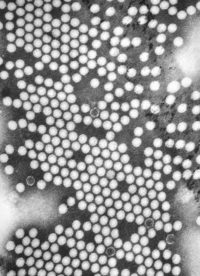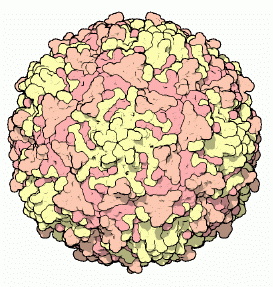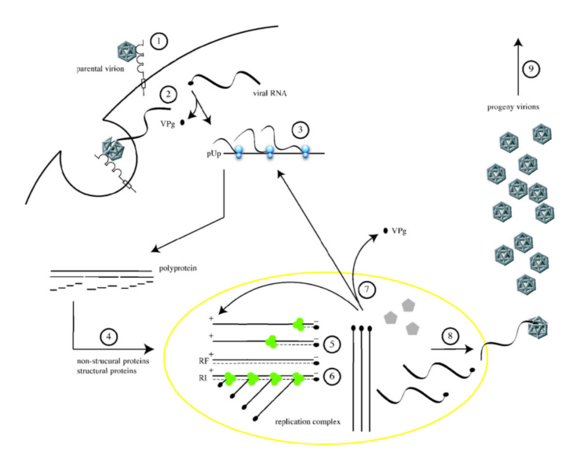Poliovirus
Articles that lack this notice, including many Eduzendium ones, welcome your collaboration! |
| Poliovirus | ||||||||
|---|---|---|---|---|---|---|---|---|
| Virus classification | ||||||||
|
Description and significance
Poliovirus was first isolated by Karl Landersteiner and Erwin Popper in 1909. Polioviruses are enteroviruses which are RNA viruses that are stable and survive in acidic conditions.
Describe the appearance, habitat, etc. of the organism, and why it is important enough to have its genome sequenced. Describe how and where it was isolated. Include a picture or two (with sources) if you can find them.
Genome structure
Poliovirus is made up of a RNA genome and a protein capsid. The genome is a linear, single-stranded, positive-strand RNA and it is approximately 7,500 nucleotides long. The viral component is about 300 Ångström in diameter with icosahdral symmetry. Poliovirus is commonly known as the most important and basic virus because of its short genome and simple composition.
Poliovirus has three serotypes; PV1, PV2, and PV3. The three serotypes are highly infectious, but differ in the capsid protein. PV1 is the most common serotype.
Describe the size and content of the genome. How many chromosomes? Circular or linear? Other interesting features? What is known about its sequence?
Does it have any plasmids? Are they important to the organism's lifestyle?
Cell structure and metabolism
The cellular life cycle of poliovirus. It is initiated by binding of a poliovirion to the cell surface macromolecule CD155, which functions as the receptor (1). Uncoating of the viral RNA is mediated by receptor-dependent destabilization of the virus capsid (2). Cleavage of the viral protein VPg is performed by a cellular phosphodiesterase, and translation of the viral RNA occurs by a cap-independent (IRES-mediated) mechanism (3). Proteolytic processing of the viral polyprotein yields mature structural and non-structural proteins (4). The positive-sense RNA serves as template for complementary negative-strand synthesis, thereby producing a double-stranded RNA (replicative form, RF) (5). Initiation of many positive strands from a single negative strand produces the partially single-stranded replicative intermediate (RI) (6). The newly synthesized positive-sense RNA molecules can serve as templates for translation (7) or associate with capsid precursors to undergo encapsidation and induce the maturation cleavage of VP0 (8), which ultimately generates progeny virions. Lysis of the infected cell results in release of infectious progeny virions (9). [1]
Ecology
Humans are the exclusive natural host for poliovirus. It cannot naturally infect other species. Monkeys and chimpanzees can be infected with poliovirus experimentally, but not naturally. Poliovirus is spread through sewage of infected people who pass their faeces.
Describe any interactions with other organisms (included eukaryotes), contributions to the environment, effect on environment, etc.
Pathology
Poliovirus causes the viral disease, poliomyelitis. Poliomyelitis is an extremely infectious disease. Humans are the exclusive natural host for poliovirus. It cannot naturally infect other species. The virus takes over the nervous system and cause paralysis in hours. Poliovirus enters the body through the mouth and replicates in the throat and intestine. Once the virus remains stable in the intestine, it can enter the blood stream and pass onto the central nervous system.
As poliovirus replicates, it damages motor neurons which control the muscles for swallowing, circulation, respiration, and the trunk, arms, and legs. The damage of the motor neurons are irreversible and can cause a condition known as acute flaccid paralysis (AFP) which affects the limbs. Paralysis involving the trunk and muscles of the thorax and abdomen can result in quadriplegia. For bulbar polio, a more severe case of polio, poliovirus attacks the motor neurons of the brain stem which cause difficulty in swallowing and speaking. Without respiratory support, bulbar polio can lead to death. In the 1940s and 50s, people infected with polio that affected their respiratory muscles were treated with "iron lungs" - metal cylinders that were worked like a pair of bellows to regulate breathing and keep them alive. Today the positive pressure ventilator replaced the iron lung.
In countries with poor sanitation, poliovirus can be spread to others by faeces of people who are infected by the virus. It can also infect vaccinated people; they will not develop polio, but can carry this virus in their gastrointestinal tract and pass it on to others.
Symptoms of infected individuals include headache, fever, vomitting, stiffness and pain in the neck and back. Poliovirus can also lead to paralysis, commonly in the legs. Some people infected with this virus do not have any symptoms and aren't aware they have been infected.
There is no known cure for poliomyelitis.
(How does this organism cause disease? Human, animal, plant hosts? Virulence factors, as well as patient symptoms.)
Application to Biotechnology
Does this organism produce any useful compounds or enzymes? What are they and how are they used?
Current Research
Summarize three current articles on poliovirus.
http://www.pubmedcentral.nih.gov/articlerender.fcgi?artid=1490301#b14
References
http://en.wikipedia.org/wiki/Poliovirus
http://www.ncbi.nlm.nih.gov/ICTVdb/ICTVdB/00.052.0.01.001.htm
http://www.ncbi.nlm.nih.gov/Taxonomy/Browser/wwwtax.cgi?lvl=0&id=12080
http://www.ncbi.nlm.nih.gov/pubmed/10618373
http://query.nytimes.com/gst/fullpage.html?sec=health&res=9A03E2D81739F933A1575AC0A963948260
http://www.sciencemag.org/cgi/content/abstract/229/4720/1358
http://www.pubmedcentral.nih.gov/articlerender.fcgi?artid=1490301


